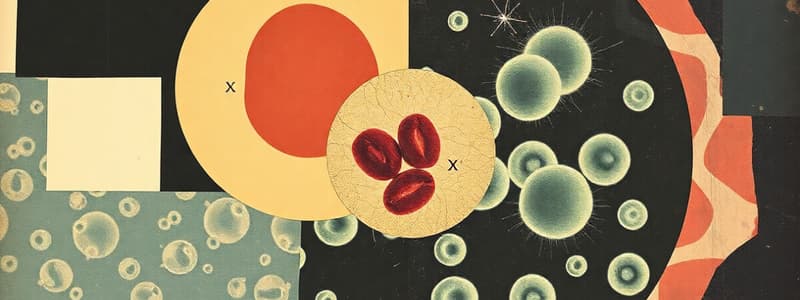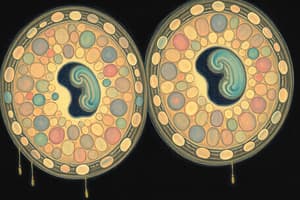Podcast
Questions and Answers
What characterizes Stage I cancer?
What characterizes Stage I cancer?
What does N0 indicate in cancer staging?
What does N0 indicate in cancer staging?
Which statement is true regarding distant metastasis (M)?
Which statement is true regarding distant metastasis (M)?
How are cancer cells classified in Grade I?
How are cancer cells classified in Grade I?
Signup and view all the answers
What type of biopsy removes the entire tumor and surrounding margins?
What type of biopsy removes the entire tumor and surrounding margins?
Signup and view all the answers
Which of the following conditions is most likely to lead to pain associated with cancer?
Which of the following conditions is most likely to lead to pain associated with cancer?
Signup and view all the answers
What is a potential consequence of hypercalcemia due to tumors?
What is a potential consequence of hypercalcemia due to tumors?
Signup and view all the answers
What does the presence of effusion in cancer patients typically indicate?
What does the presence of effusion in cancer patients typically indicate?
Signup and view all the answers
Which type of tumor is most likely to result in disseminated intravascular coagulation (DIC)?
Which type of tumor is most likely to result in disseminated intravascular coagulation (DIC)?
Signup and view all the answers
Which factor can enhance hypercalcemia in cancer patients?
Which factor can enhance hypercalcemia in cancer patients?
Signup and view all the answers
What type of cancer is specifically mentioned as commonly causing hypercalcemia?
What type of cancer is specifically mentioned as commonly causing hypercalcemia?
Signup and view all the answers
What is a likely cause of edema in cancer patients?
What is a likely cause of edema in cancer patients?
Signup and view all the answers
What common symptom indicates that cancer might be advanced?
What common symptom indicates that cancer might be advanced?
Signup and view all the answers
What is the primary purpose of interphase in the cell cycle?
What is the primary purpose of interphase in the cell cycle?
Signup and view all the answers
What phase of the cell cycle do stable cells primarily reside in?
What phase of the cell cycle do stable cells primarily reside in?
Signup and view all the answers
Which of the following cells would be considered labile cells?
Which of the following cells would be considered labile cells?
Signup and view all the answers
Permanent cells are characterized by which of the following traits?
Permanent cells are characterized by which of the following traits?
Signup and view all the answers
What is the role of the G1 checkpoint in the cell cycle?
What is the role of the G1 checkpoint in the cell cycle?
Signup and view all the answers
During which phase does DNA replication actually take place?
During which phase does DNA replication actually take place?
Signup and view all the answers
What distinguishes discontinuous replication from continuous cell division?
What distinguishes discontinuous replication from continuous cell division?
Signup and view all the answers
Which type of cell is likely to enter the cell cycle when stimulated?
Which type of cell is likely to enter the cell cycle when stimulated?
Signup and view all the answers
What is the primary management option for neutropenia in patients undergoing chemotherapy?
What is the primary management option for neutropenia in patients undergoing chemotherapy?
Signup and view all the answers
What should be done immediately if a patient is found to have heart muscle damage during chemotherapy?
What should be done immediately if a patient is found to have heart muscle damage during chemotherapy?
Signup and view all the answers
Which of the following is NOT a preparation step prior to chemotherapy?
Which of the following is NOT a preparation step prior to chemotherapy?
Signup and view all the answers
What type of cancer treatment is hormone therapy primarily used for?
What type of cancer treatment is hormone therapy primarily used for?
Signup and view all the answers
Which of the following is a method of managing hemorrhagic cystitis?
Which of the following is a method of managing hemorrhagic cystitis?
Signup and view all the answers
Which medication is commonly used to neutralize chemotherapy infiltration?
Which medication is commonly used to neutralize chemotherapy infiltration?
Signup and view all the answers
Which statement about hormone therapy is accurate?
Which statement about hormone therapy is accurate?
Signup and view all the answers
What complication can arise from kidney issues during chemotherapy?
What complication can arise from kidney issues during chemotherapy?
Signup and view all the answers
What is the primary function of hormone therapy in the treatment of prostate cancer?
What is the primary function of hormone therapy in the treatment of prostate cancer?
Signup and view all the answers
Which of the following is an example of an antiandrogen used in hormone therapy for prostate cancer?
Which of the following is an example of an antiandrogen used in hormone therapy for prostate cancer?
Signup and view all the answers
Which serious risk is associated with the use of tamoxifen?
Which serious risk is associated with the use of tamoxifen?
Signup and view all the answers
What are possible side effects of hormone therapy mentioned?
What are possible side effects of hormone therapy mentioned?
Signup and view all the answers
Which therapy is mentioned as effective for relieving symptoms of advanced prostate cancer?
Which therapy is mentioned as effective for relieving symptoms of advanced prostate cancer?
Signup and view all the answers
What effect does LHRH agonists have on testicular androgen levels?
What effect does LHRH agonists have on testicular androgen levels?
Signup and view all the answers
What additional risk does tamoxifen pose for women specifically?
What additional risk does tamoxifen pose for women specifically?
Signup and view all the answers
Which of the following is NOT a noted side effect of hormone therapy for prostate cancer?
Which of the following is NOT a noted side effect of hormone therapy for prostate cancer?
Signup and view all the answers
Study Notes
The Cell Cycle
- A vital process by which a single-celled fertilized egg develops into a mature organism
- The cycle also plays a key role in tissue and organ renewal
- The cell cycle consists of two distinct periods: Interphase and Mitosis
- Interphase is when the cell grows, accumulates nutrients needed for mitosis and duplicates its DNA
- Mitosis is when the cell splits into two distinct cells, called daughter cells
- Activation of each phase of the cell cycle is dependent on the completion of the previous phase
Types of Cells
- Stable cells: Multiply only when needed, spend most of their time in the Go phase of the cell cycle, and can be stimulated to enter the cell cycle when needed
- Examples of stable cells include liver cells, proximal tubules of the kidneys, and endocrine glands
- Labile cells: Multiply constantly throughout life
- Examples of labile cells include GI lining, bone marrow, and hair
- Permanent cells: Incapable of reproduction or multiplication
- Examples of permanent cells include brain cells, heart cells, and skeletal muscle cells
Phases of the Cell Cycle
- Gap 0/G0: A resting phase where the cell has left the cycle and has stopped dividing
-
Interphase: Consists of three subphases:
- Gap 1/G1: Cells increase in size, and the G1 checkpoint control mechanism ensures that everything is ready for DNA synthesis
- Synthesis/S: DNA replication occurs
- Gap 2/G2: The cell prepares for mitosis
Cancer
- Pain: Can be caused by pressure on nerve endings, distention of organs or vessels, or lack of oxygen to tissues and organs
- Effusion: Occurs when lymphatic flow is obstructed, leading to fluid build-up in serous cavities
Cancer Staging
- Stage I: Cancer is only in the cells where it first started, and the area is small. Considered early stage and often curable.
- Stage II: Cancer is in the organ where it first started, and may be larger than Stage I.
- Stage III: Cancer has spread to nearby lymph nodes or tissues.
- Stage IV: Cancer has spread to distant parts of the body.
Cancer Grading
- Grade I: Cancer cells resemble normal cells.
- Grade II: Cancer cells are somewhat abnormal.
- Grade III: Cancer cells are very abnormal.
- Grade IV: Cancer cells are highly abnormal.
Hormone Therapy
- Used to treat cancers that utilize hormones for growth, like prostate and breast cancers
- Works by slowing or stopping the growth of cancer cells
- Approaches:
- Suppressing the production of hormones
- Blocking the action of hormones
- Removing glands that produce hormones
Side Effects of Hormone Therapy
- Fatigue
- Skin rash
- Loss of appetite or weight gain
- Headaches
- Vaginal dryness, itching, or irritation of the skin around the vagina
- Increased risk of blood clots, stroke, and eye problems
- Increased risk of endometrial cancer and uterine sarcoma
Biopsy Types
- Excisional: For easily accessible tumors, the entire tumor and surrounding marginal tissues are removed
- Incisional: A sample of tissue is removed for examination
- Needle: A small sample of tissue is withdrawn using a needle.
Chemotherapy
- Pre-medication: Given prior to chemotherapy to help prevent side effects.
-
Side Effects:
- Cardiac: Heart muscle damage
- Respiratory: Pulmonary fibrosis
- Genitourinary: Hemorrhagic cystitis and loss of libido
- Kidney: Renal failure
-
Neutropenia (Low White Blood Cell Count):
- Stop medication administration immediately.
- Ice application (except for vinca alkaloids).
- Aspiration of infiltrated medication (by the physician).
- Injection of neutralizing solution (e.g., sodium thiosulfate, sodium bicarbonate).
- Plastic Surgery Consultation
Causes of Cancer
-
Physical Agents:
- Exposure to radiation
- Exposure to sunlight
-
Other etiologies (causes):
- Viral infections
- Genetic predisposition
- Environmental factors
- Lifestyle choices
Disseminated Intravascular Coagulation (DIC)
- Can occur with all tumors, but is more likely with cancer of the lung, pancreas, stomach, and colon.
- Characterized by abnormal blood clotting and bleeding throughout the body.
Edema
- Caused by obstructed blood and lymphatic flow
- A result of decreased serum protein from anorexia and malnutrition
- Can contribute to swelling in various parts of the body.
Hypercalcemia
- Occurs due to tumors of the bone, multiple myeloma, squamous lung cancer, and cancer of the breast.
- Results from metastasis to the bone and increased bone breakdown.
- Production of a parathyroid-like hormone enhances the release of calcium from the bones.
Additional Notes
-
TNM Staging System: This system uses three main categories to describe the extent of cancer:
- T (Tumor): Describes the size and location of the primary tumor.
- N (Nodes): Describes whether the cancer has spread to nearby lymph nodes.
- M (Metastasis): Describes whether the cancer has spread to distant parts of the body.
Studying That Suits You
Use AI to generate personalized quizzes and flashcards to suit your learning preferences.
Related Documents
Description
Explore the key phases of the cell cycle, including Interphase and Mitosis, and understand the characteristics of stable, labile, and permanent cells. This quiz will test your knowledge on how these processes contribute to growth and tissue renewal in organisms.




